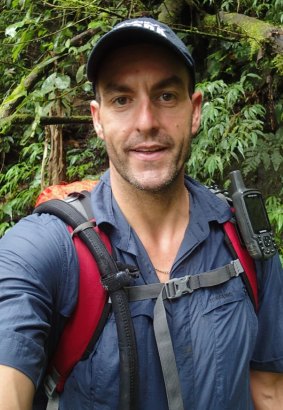This was published 4 years ago
Walking the Kokoda Track: Five things you need to know
By Belinda Jackson

Chris Stevens hiking the Kokoda Trail.
Chris Stevens has been guiding people on the Kokoda Track for over 16 years for Port Moresby-based PNG Trekking Adventures. In that time, he has walked the trail more than 39 times, and he recently hosted BBC Earth's episode of Extreme Treks on Kokoda, www.pngtrekkingadventures.com
STEP ONE
The Kokoda Track is a historical, emotional, physical and cultural extravaganza, and it's the combination of those elements that makes it so special. There are many tough treks around the world that will physically smash you. You can go to Gallipoli if you want only war history. But Kokoda gives you the opportunity to immerse yourself in all these facets.
STEP TWO
Nearly 100 operators run tours across Kokoda but, when choosing one, investigate if your tour group is foreign or local. PNG companies keep the profits and wages in the country, which is important to help the developing nation's employment and economic growth. Also, check if tents are included (you can never be guaranteed a guest house on the track) and whether your guide is a historian.
STEP THREE
The most frequent question I get asked about Kokoda is, "Should I carry my own pack or employ a personal porter?" It's roughly an even split on what people choose. You may be strong and fit enough to carry your own pack, but the question is: will it take enjoyment away from your experience due to the extra exhaustion? The bonus of hiring a porter is that you are employing a local and aiding the economy. You'll still need to carry a day pack of about 8 kilograms and the porter's pack should be no heavier than 16 kilograms.
STEP FOUR
You cannot over-train for Kokoda, but you can under-train. Start up to six months before, and mix endurance walking with strength sessions. Use a gym and find a steep hill for repeat efforts. Try to add multi-day hikes as part of your training. Nothing will train you for the humidity or heat, but you can be in adequate physical shape to deal with it.
STEP FIVE
Invest in the right equipment. Boots should have a solid grip and rubber toe-cap, and pack a pair of good socks for each day. Walking poles – one or two – are a lifeline on Kokoda (second to the porters, of course), and avoid compression clothing for your outer layer as it rips easily. Don't bother with a daily change of clothes, two sets will do, as everything ends up smelling, to which you rapidly become desensitised. Also, nothing dries, so expect to dress in wet clothes in the mornings.
Sign up for the Traveller newsletter
The latest travel news, tips and inspiration delivered to your inbox. Sign up now.